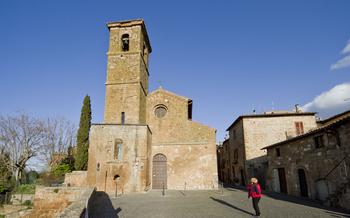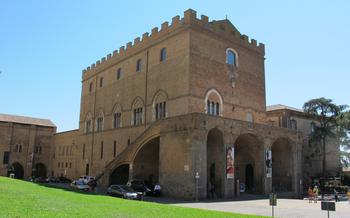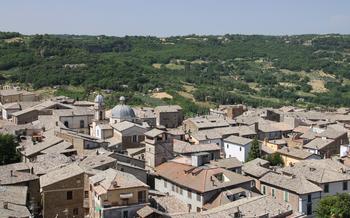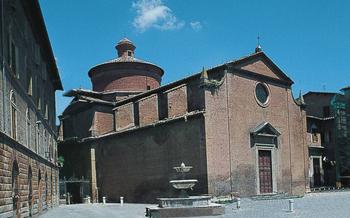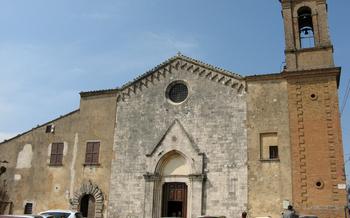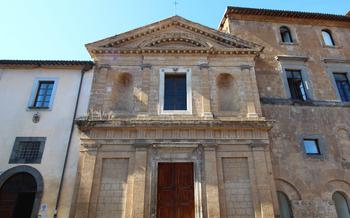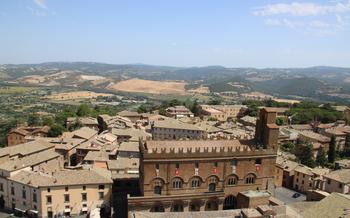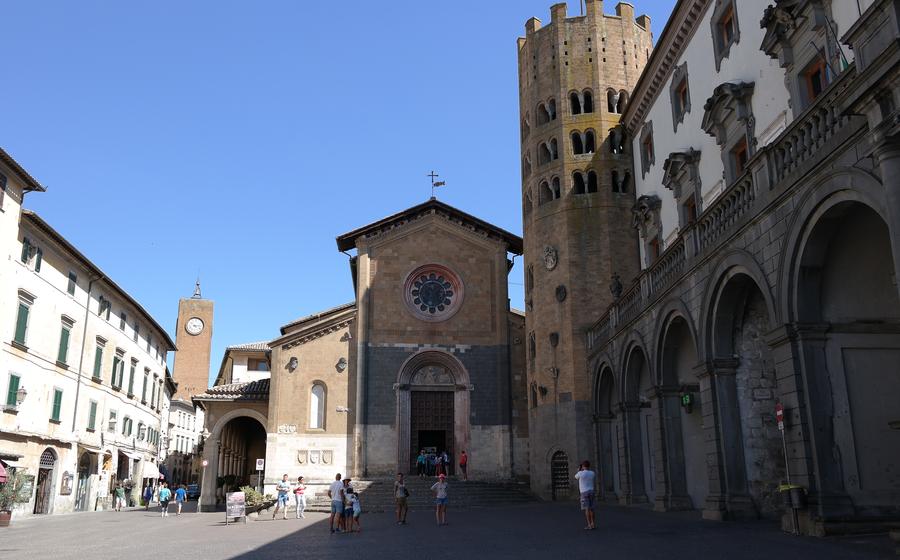
Chiesa di Sant'Andrea
- Orvieto, a Timeless Masterpiece in Central Italy
- Historical Significance
- Architectural Style
- Location
- Façade
- Interior
- Frescoes and Artworks
- Altarpiece
- Side Chapels
- Cloister
- Underground Oratory
- Guided Tours
- Opening Hours
- Admission Fee:
- Insider Tip:
Orvieto, a Timeless Masterpiece in Central Italy
Amidst the rolling hills and picturesque landscapes of Central Italy, the enchanting town of Orvieto stands as a testament to the rich history and artistic heritage of the region. This hilltop gem, renowned for its stunning Gothic architecture and breathtaking views, offers visitors a glimpse into a bygone era. As you wander through Orvieto's cobbled streets, you'll encounter a treasure trove of medieval wonders, each telling a unique story of the town's storied past. Among these architectural marvels, the Chiesa di Sant'Andrea stands out as a beacon of spirituality and artistic achievement.
Historical Significance
The Chiesa di Sant'Andrea holds a significant place in the historical and cultural fabric of Orvieto. It was one of the first Christian churches built within the city walls and served as a crucial religious center during the Middle Ages. The church played a pivotal role in the political and social life of Orvieto, hosting important civic events, meetings, and even trials. Throughout the centuries, it has witnessed significant historical moments, leaving an indelible mark on the city's heritage.
The church's construction coincided with a period of great religious fervor and the rise of Christianity in the region. Its location near the town hall emphasizes its importance as a civic and religious monument. The church served as a place of worship and gathering for the community, fostering a sense of unity and belonging among the citizens of Orvieto.
Architectural Style
The Chiesa di Sant'Andrea stands as a testament to the architectural prowess of the 13th century. Its Gothic style, characterized by soaring pointed arches, ribbed vaults, and intricate tracery, is evident throughout the structure. The church's exterior is adorned with an array of intricate carvings, sculptures, and decorative elements, showcasing the artistic influences of the period. The interior features a spacious nave flanked by elegant aisles, creating a sense of grandeur and devotion. The ribbed vaults, supported by slender columns, add a sense of verticality and lightness to the space, while the stained-glass windows cast a warm, ethereal glow upon the interior.
Location
The Chiesa di Sant'Andrea is conveniently located in the historic center of Orvieto, easily accessible by foot from the city's main attractions. To reach the church, visitors can follow the signs from Piazza del Duomo, the town's main square. Alternatively, one can take Via del Duomo and turn left onto Via San Giovanni. The church is situated on Via Sant'Andrea, just a short walk from the Palazzo del Popolo. Its exact address is Via Sant'Andrea, 32, 05018 Orvieto TR, Italy.
Façade
The façade of the Chiesa di Sant'Andrea is a testament to the artistic and architectural prowess of its creators. Constructed using primarily travertine stone, the exterior of the church exudes an aura of grandeur and elegance. The lower section of the façade features three intricately carved portals, each adorned with intricate bas-reliefs depicting scenes from the life of Christ and the saints. Above the portals, a row of delicate arcades adds a touch of lightness and symmetry to the composition. The upper section of the façade is dominated by a beautiful rose window, its intricate tracery creating a mesmerizing play of light and shadows. The window is flanked by two slender bell towers, their pointed spires reaching towards the heavens, adding a touch of verticality to the overall design.
Interior
The interior of the Chiesa di Sant'Andrea is a symphony of art and architecture, showcasing the grandeur of the Renaissance era. Step through the threshold and be awestruck by the spacious nave, flanked by graceful columns that soar towards the heavens. The rhythmic arches, crafted with precision, create a sense of harmony and unity throughout the sacred space. Overhead, the ribbed vaulting adds a touch of complexity to the ceiling, drawing the eye upwards to admire the intricate details.
As you wander through the church, take note of the side aisles, which provide a more intimate setting for contemplation and prayer. The transepts, which extend perpendicular to the nave, create a cruciform layout, emphasizing the church's significance as a place of worship. The sanctuary, bathed in ethereal light, houses the main altar, an exquisite masterpiece that commands attention with its intricate carvings and gleaming gold accents.
Frescoes and Artworks
The Chiesa di Sant'Andrea is a treasure trove of stunning frescoes and artworks that adorn its interior walls and ceiling, creating a breathtaking visual feast for visitors. The church's nave, aisles, transepts, and apse are adorned with intricate frescoes depicting scenes from the Bible, the lives of saints, and the history of Orvieto.
The most renowned frescoes are the works of the 14th-century Sienese artist, Ambrogio Lorenzetti. His masterpiece, the "Life of the Virgin", adorns the walls of the right transept and depicts the life of Mary, the mother of Jesus, from her birth to her assumption into heaven. Lorenzetti's frescoes are characterized by their exquisite detail, vibrant colors, and expressive figures that seem to come alive before the viewer's eyes.
Another notable artist whose works grace the church is the Florentine painter, Ugolino di Nerio. His frescoes in the left transept depict scenes from the life of Jesus, including the Crucifixion and the Resurrection. Ugolino's style is more dramatic and emotional compared to Lorenzetti's, conveying the intensity and power of the depicted events.
The ceiling of the church is adorned with a stunning fresco of the "Assumption of the Virgin" by the 16th-century artist, Cesare Nebbia. This grand fresco depicts the Virgin Mary being lifted into heaven by a host of angels, surrounded by a celestial radiance. Nebbia's fresco is a testament to the High Renaissance style, with its harmonious composition, skillful use of perspective, and vivid colors.
These frescoes and artworks are not mere decorations; they are powerful tools that communicate religious teachings, inspire devotion, and transport visitors to a realm of spiritual contemplation. They represent the artistic genius of their creators and stand as a testament to the enduring power of art to transcend time and inspire generations.
Altarpiece
The main altarpiece of the Chiesa di Sant'Andrea is a breathtaking masterpiece that commands attention in the church's interior. Crafted with intricate detail and artistry, the altarpiece serves as a focal point for worship and devotion. The central panel depicts a poignant scene, inviting viewers to contemplate its religious significance. The figures are rendered with lifelike precision, capturing the essence of the depicted moment. The altarpiece's design and symbolism reflect the profound theological themes that permeate the church's atmosphere, offering visitors a glimpse into the spiritual heart of Orvieto's history and faith.
Side Chapels
The Chiesa di Sant’Andrea boasts several side chapels, each with unique features and dedications that add to the church’s rich historical and artistic tapestry.
One notable chapel is the Cappella del Santissimo Sacramento, dedicated to the Holy Sacrament. This chapel is adorned with intricate frescoes depicting scenes from the life of Christ. The walls are lined with marble panels, and the altar features a beautiful tabernacle with a gold leaf finish. Visitors can marvel at the delicate details and craftsmanship that went into creating this sacred space.
Another must-see chapel is the Cappella di Sant’Antonio Abate, which is dedicated to Saint Anthony Abbot. This chapel is known for its stunning altarpiece, which depicts the saint surrounded by angels and cherubs. The walls are adorned with frescoes that tell the story of Saint Anthony’s life and his many miracles. Visitors will be captivated by the vibrant colors and expressive figures that bring the saint’s story to life.
Cloister
While the Chiesa di Sant'Andrea might not have a traditional cloister, it does feature a stunning internal courtyard, known as the "Chiostro dei Canonici" or "Canon's Cloister." This serene space is a hidden gem within the church, offering a tranquil escape from the bustling city streets. The Chiostro dei Canonici is characterized by its elegant Renaissance architecture, with graceful arches supported by slender columns. Visitors can wander through this peaceful courtyard, admiring the intricate details of the surrounding architecture and enjoying the soothing atmosphere. The courtyard is often used for hosting events and exhibitions, providing a unique and enchanting setting for these special occasions.
Underground Oratory
Beneath the Chiesa di Sant'Andrea lies a hidden gem—an atmospheric underground oratory or crypt. This subterranean space is a testament to the rich history and devotion that have marked Orvieto's religious landscape for centuries. While the exact date of its construction is uncertain, the oratory is believed to have originated in the early Christian era, possibly as a place of refuge and worship during times of persecution.
Descending into the crypt, visitors are greeted by a dimly lit, ethereal atmosphere that transports them back in time. The walls are adorned with evocative frescoes, many of which have been weathered and faded by the passage of time, lending them an air of mystery and intrigue. These frescoes depict biblical scenes, saints, and other religious figures, offering a glimpse into the beliefs and devotion of the early Christian community.
Among the most notable features of the underground oratory is a small altar, intricately carved from stone and adorned with delicate bas-reliefs. This altar serves as a reminder of the sacred purpose of this subterranean space, where prayers and rituals were once performed in the flickering light of candles.
Visiting the underground oratory is an immersive and evocative experience that provides a deeper understanding of Orvieto's religious heritage. It is a place of quiet contemplation, where visitors can connect with the past and marvel at the enduring power of faith.
Guided Tours
Guided tours of the Chiesa di Sant'Andrea offer an immersive and informative experience for visitors who seek a deeper understanding of the church's history, architecture, and artwork. Knowledgeable guides lead visitors through the various sections of the church, providing insights into its construction, religious significance, and the stories behind the stunning frescoes and sculptures.
These guided tours typically cover the history of the church's construction and its role in the religious and political life of Orvieto. Guides point out architectural highlights, such as the intricate façade and the impressive interior design, explaining the symbolism and meanings behind various elements. They also provide detailed descriptions of the stunning frescoes that adorn the church's interior, highlighting the techniques and styles of the artists who created these masterpieces.
For art enthusiasts, the guided tours offer an opportunity to learn about the different artistic periods represented in the church and to appreciate the unique styles of the various artists who contributed to its decoration. The guides provide historical context and insights into the lives and influences of these artists, making the visit a truly enriching experience.
Overall, guided tours of the Chiesa di Sant'Andrea are highly recommended for visitors who wish to delve deeper into the church's rich history, stunning architecture, and remarkable artwork. They provide a comprehensive and engaging experience that leaves visitors with a lasting appreciation for this magnificent masterpiece of Italian religious art.
Opening Hours
The Chiesa di Sant'Andrea is generally open to the public from 8:00 AM to 12:00 PM and from 4:00 PM to 6:00 PM daily, except on Sundays and public holidays, when it is open from 10:00 AM to 12:00 PM. It is advisable to visit the church during these designated hours to ensure access and avoid inconvenience. However, it is always recommended to check the official website or contact the parish office in advance to confirm the exact opening hours, as they may be subject to change due to special events, religious services, or unforeseen circumstances.
Admission Fee:
Exploring the Chiesa di Sant'Andrea is generally free of charge, allowing visitors to admire its architectural wonders and sacred treasures without incurring any financial burden. However, for those seeking a deeper understanding of the church's history and significance, guided tours are available at a modest fee. These tours, led by knowledgeable guides, offer an insightful journey through the church's past, shedding light on its religious importance, artistic masterpieces, and captivating stories. Therefore, while admission to the church itself is complimentary, visitors who wish to delve further into its secrets may consider investing in a guided tour to enhance their experience.
Insider Tip:
To fully appreciate the beauty and tranquility of the Chiesa di Sant'Andrea, consider visiting during the early morning or late afternoon hours when the crowds are fewer. This will allow you to immerse yourself in the sacred atmosphere and admire the intricate details of the church's artwork and architecture without distractions. Additionally, if you happen to stumble upon a local religious ceremony or music concert taking place within the church, don't hesitate to attend. These events offer a unique opportunity to witness the living traditions of Orvieto and experience the spiritual essence of this magnificent religious edifice.
